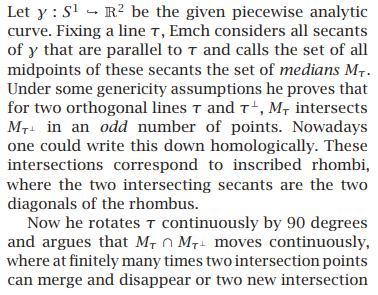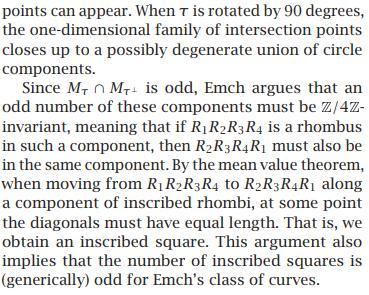Answered step by step
Verified Expert Solution
Question
1 Approved Answer
Let y : S' - R2 be the given piecewise analytic curve. Fixing a line T, Emch considers all secants of y that are


Let y : S' - R2 be the given piecewise analytic curve. Fixing a line T, Emch considers all secants of y that are parallel to T and calls the set of all midpoints of these secants the set of medians M7. Under some genericity assumptions he proves that for two orthogonal lines T and T-, M, intersects M7 in an odd number of points. Nowadays one could write this down homologically. These intersections correspond to inscribed rhombi, where the two intersecting secants are the two diagonals of the rhombus. Now he rotates T continuously by 90 degrees and argues that M, n M7- moves continuously, where at finitely many times two intersection points can merge and disappear or two new intersection points can appear. When t is rotated by 90 degrees, the one-dimensional family of intersection points closes up to a possibly degenerate union of circle components. Since M7 n M7- is odd, Emch argues that an odd number of these components must be Z/4Z- invariant, meaning that if R1R2R3 R4 is a rhombus in such a component, then R2R3R4R1 must also be in the same component. By the mean value theorem, when moving from R1 R2R3R4 to R2R3R4R1 along a component of inscribed rhombi, at some point the diagonals must have equal length. That is, we obtain an inscribed square. This argument also implies that the number of inscribed squares is (generically) odd for Emch's class of curves.
Step by Step Solution
★★★★★
3.48 Rating (168 Votes )
There are 3 Steps involved in it
Step: 1

Get Instant Access to Expert-Tailored Solutions
See step-by-step solutions with expert insights and AI powered tools for academic success
Step: 2

Step: 3

Ace Your Homework with AI
Get the answers you need in no time with our AI-driven, step-by-step assistance
Get Started


